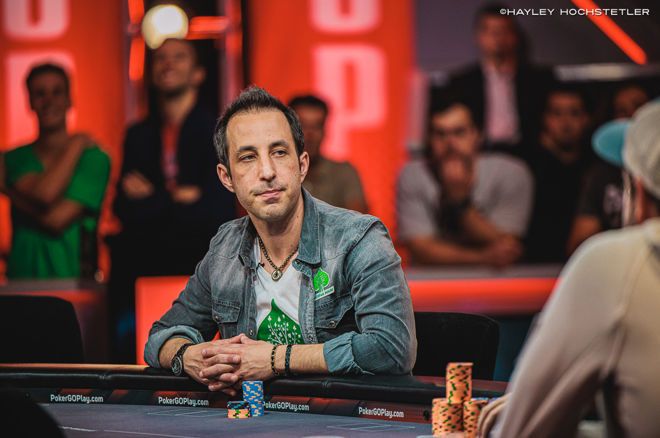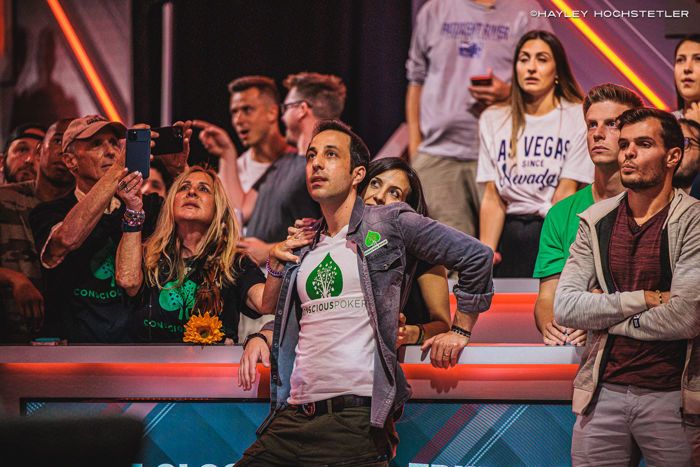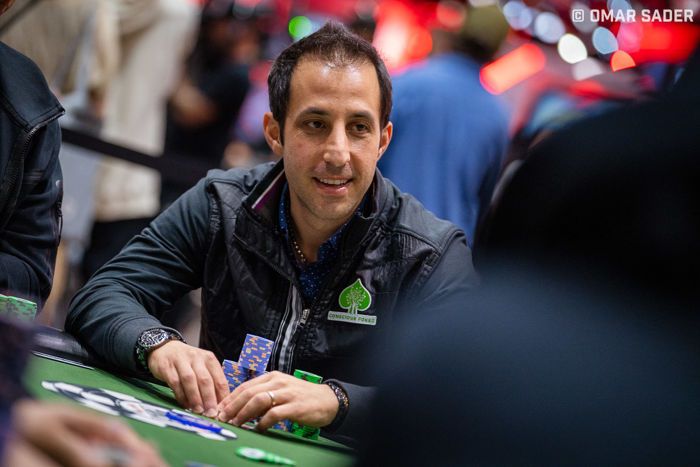
We’re back in action on Day 4 of the World Series of Poker (WSOP) Main Event with another “Hand of the Day” breakdown. For those new to the series, here are the earlier installments of the series:
It’s midway through Day 4, the money bubble just burst, and we’re guaranteed $25,000 in prize money for our effort thus far. It’s no small sum, of course, but as any poker player can attest, it’s as much of a disappointment as it is a success. Let’s be real, you don’t sign up for the Main Event to min-cash.
We just wrapped up a break and are coming back to 6,000/12,000 blinds with a 12,000 big blind ante. I have 67 big blinds, an above-average stack. Using some aggressive play on the bubble, I ran up a solid stack to 802,000 when the following hand took place.
Preflop
I looked down at the K♥J♣ in the cutoff and made a standard raise to 25,000. A young pro, who had been fairly active, put in a reraise to 80,000 from the small blind.
In spots like these, it’s imperative to analyze whether or not your opponent can be squeezing light. King-Jack is considered a ‘trouble’ hand, meaning you’ll find yourself in a tough spot post flop, even if you flop a pair.
The reason is because it is reasonable that your opponent will have your hand in bad shape with stronger holdings such as KxQx, AxKx, AxJx, and JxJx+.
I usually default to folding here, but in this particular situation, I felt confident he was capable of squeezing with a wide range of hands. My read on him, combined with my positional advantage, deep stack, and faith in my post-flop game allowed me to make this speculative call.
Put another way, had I been up against a more conservative player, had a shallower stack, or less of a read, I would have simply pitched this hand and opted for a better spot.
Nevertheless, I called, and the flop is where things get interesting.
Click here to see the 2024 WSOP schedule!
The Flop
With 184,000 in the pot, the flop fell K♠Q♠6♠, and my opponent bet 45,000, which I called.
Monotone flops don’t heavily favor either player, since both players contain roughly equal flush holdings. Hence, I I expected him to utilize a small bet sizing here for balance.
That said, not all monotone flops are created equal. High-card boards containing both a King and Queen should, in theory, favor my opponent’s range as he is three-betting preflop with many of the Broadway hands, which now make a pair on this board. He’s also more likely to have flopped a set of Kings or Queens than me since I didn’t put in a four-bet preflop.
Still, with top pair and no spade draw, I had a standard call.

The Turn
With 274,000 in the pot, the dealer burned and turned the 6♥ and my opponent bet 105,000, which I again called.
Things change dramatically when my opponent bet again on this turn. He no longer has hands like Qx or under pairs, which may put in a standard continuation-bet on the flop.
With a turn bet of this size, my opponent is conveying that he either has a strong hand for value, such AxKx or better, or a bluff.
In my experience in coaching clients and helping them improve at hand reading, most underestimate how dramatically hand ranges change on the turn when someone double barrels.
They often become ‘polarized’, meaning they contain strong value holdings, hands like top pair with a solid kicker at a bare minimum, or air.
“If he’s betting for value, I’m in terrible shape and should fold. If he’s bluffing, I’m ahead and should call.”
When I call the flop, I have an uncapped range, meaning I could still have flushes, sets, and two pair. For this reason, it’s unwise for my opponent to bet a mediocre hand. He would prefer to simply check.
With this in mind, the question becomes, “Do I put him on a strong or weak hand?” I’m a big fan of giving people simple frameworks to help them make better decisions in real time. Many have found this binary question, in particular on the turn, to be quite effective.
Here’s why. If he’s betting for value, I’m in terrible shape and should fold. If he’s bluffing, I’m ahead and should call.
I love live poker because spots like these arise that put you to the test. They force you to make a critical decision that could define your entire session or tournament.
Facing this bet on the turn, I felt quite confident he was semi-bluffing. Possible holdings are hands like AxJx, Ax10x, or Jx10x, most likely with a spade.
My plan was to call the turn and fold if a spade rolled off.
Check out more strategy content from PokerNews here!
The River
With 484,000 in the pot, the Q♥ completed the board on the river and he immediately jammed for 301,000.
WTF!? I flat the flop and turn, showing strength. I can still have all the flushes, as well as KxQx or even some Qx hands that contain a spade (like AxQx for example), which have now improved to a full house.
Why is he shoving into such a strong range? Would he really do that with AxAx, AxKx or even a small flush?
Knowing I could have a boat, he’d surely think about it for a few seconds with a small flush, no?
Four key things factored into my river decision:
-
My read was always that he was weak. This made me feel he was more likely at the bottom of his range (with bluffs) than at the top of his range (with value).
The timing of his bet on a board texture-changing card made me discount mediocre value hands like AxKx, AxAx, and even small flushes. This makes his range even more polarized. I ranged him on a full house or air. Perhaps he can have the nut flush in between, but that’s about it.
- It’s very hard for my opponent to have a boat. As we discussed earlier, most of his Qx hands don’t bet the turn, for fear of only being called by better holdings. This means his only full-house combos are KxKx and KxQx.
- Having a king in my hand reduces the probability I’m up against a boat since I block some of those combinations. Notably, I also do not have a spade, which means I unblock his bluffs.

Before making my decision, I did some tournament-specific analysis.
If I call and lose, I still have 250,000, or roughly 20 big blinds to work with. While that’s not ideal, it’s a playable stack and one double away from average. I certainly don’t need to make this call, as folding still leaves me with an above-average stack. Therefore, I’m willing to give up a modest edge to wait for a better spot.
But the longer I sat there and the more I observed him and replayed the hand in my head, the more I couldn’t shake the feeling that I knew the right play was to call. As any poker player can attest, knowing the right play and being able to make it under pressure are two very different things.
“I sat for a moment to shake the fear of looking stupid, potentially crippling myself in my deepest Main Event run ever, and worse yet, doing it in a spot where I’m calling off all my chips.”
I sat for a moment to shake the fear of looking stupid, potentially crippling myself in my deepest Main Event run ever, and worse yet, doing it in a spot where I’m calling off all my chips. In tournaments, you typically want to be the one putting them to the test!
Through techniques that I’ve refined over the years, I was able to silence the fear, be present, and listen to myself. I don’t always get this right, and it’s a continuous battle to find the courage to execute, but this time I got there.
I flicked in a chip, and his body sank into the chair. He let out a sigh, covering his face with his hands. “You’re good”, he said flipping over the A♥8♦.
He didn’t even have a spade; a stone-cold bluff!
This hand catapulted me up to 1,350,000 and put me in a commanding position to cruise through the rest of Day 4. It was one of the pivotal moments and the first time I felt like I could make a run for it.
Stay tuned for the next installment in this series where I explore a key hand from Day 5 of the 2023 WSOP Main Event!
For more awesome poker content, including our free weekly newsletter, check out ConsciousPoker.com.
Alec Torelli has been playing high-stakes poker professionally since 2006. With over $1,500,000 in tournament winnings and millions more in both live and online cash games, Alec is one of the most respected poker players in the industry today. He has been featured on ESPN, CBS Sports, Travel Channel, Fox Sports, Cigar Aficionado, PokerNews, and many more.
In 2015, Alec founded Conscious Poker to teach poker players how to improve their game, move up in limits, and achieve their poker goals. Since then, Alec has coached nearly a hundred players both in person and virtually, and thousands more have taken his programs to take their game to the next level.



